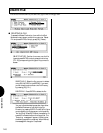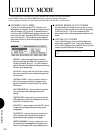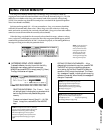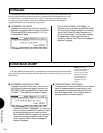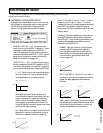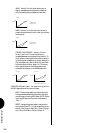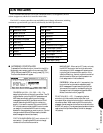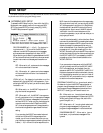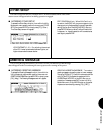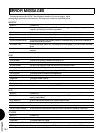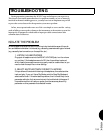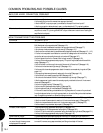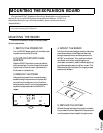
UTILITY MODE
148
MIDI SETUP
The MIDI Setup function lets you determine the W5/W7 device number, set local
keyboard status and set program change status.
● ACCESSING MIDI SETUP
To access the MIDI Setup function, from within the Utility
Mode main menu screen, position the cursor over MIDI
SETUP and press ENTER, or simply press [F6] ( MIDI ).
The MIDI Setup screen will appear.
DEVICE NUMBER (off, 1 ~ 16, all) - For determin-
ing the channel (1 ~ 16) on which the W5/W7 will
receive or transmit MIDI system exclusive messages,
such as parameter changes and bulk data. (NOTE:
When receiving and transmitting data between the W5/
W7 and external devices, the device number parameter
for each instrument must be assigned the same num-
ber.)
OFF - When set to off , system exclusive messages
will not be transmitted or received.
ALL - When set to all , system exclusive messages
will be transmitted on channel 1 and received on
any channel.
LOCAL (off, on) - For determining whether or not the
keyboard will play the W5/W7 s tone generator. If you
are using the W5/W7 by itself, you should usually leave
Local set to on .
ON - When set to on the W5/W7 keyboard will
play the internal tone generator
OFF - When set to off , the W5/W7 s tone genera-
tor will produce sound only in response to messages
from MIDI IN; however, messages will be transmit-
ted from MIDI OUT when you play the keyboard or
move the various controllers. Data from the W5/
W7 s internal song sequencer will always be sent to
the internal tone generator regardless of the Local
setting.
If you are using the W5/W7 as a master keyboard
controller with other MIDI tone generators con-
nected, you will want to leave Local off so you can
play the other tone generators by selecting one of the
tracks (1 ~ 16) in the multi that corresponds to the
MIDI channel of the desired external tone generator.
Although when Local is off you cannot play the W5/
W7 s tone generator from the multi in Song Mode,
the keyboard still sends MIDI data to the internal
song sequencer. As you record, the MIDI data will
echo back from the internal sequencer to the
internal tone generator, so you can hear what you re
playing as you record.
Local off can also be useful in other situations. Some
commercially available MIDI processing devices are
able to receive a stream of MIDI note and controller
data and process it to create parallel harmony or
other musical effects. If you have this type of MIDI
processing unit, it may be interesting to turn the
W5/W7 local setting off and make MIDI connections
so that the note and controller data transmitted from
the W5/W7 s MIDI OUT is processed by the MIDI
processing unit and then transmitted back to the
W5/W7 s MIDI IN.
If you use an external sequencer with the W5/W7,
you will probably record from the W5/W7 s MIDI
OUT to the sequencer, and playback from the
sequencer s MIDI OUT to the W5/W7 s MIDI IN. If
the external sequencer is able to echo back (retrans-
mit) the data being recorded, you can turn Local off
so the W5/W7 will produce sound only in response
to data from the external sequencer.
PROGRAM CHANGE (off, on, ignore bank select) -
For determining how the W5/W7 responds when a
program change message is received at MIDI IN, and
how program change messages are transmitted from
MIDI OUT. Usually you will leave this set to on .
ON - When set to on , incoming bank select and
program change messages will be executed. (NOTE:
When loading data from floppy disk, set the Pro-
gram Change to on .)
OFF - When set to off , incoming bank select and
program change messages will be ignored, and
program change messages will not be transmitted.
IGNORE BANK SELECT - When set to ignore
bank select , only bank select messages will be
ignored.



